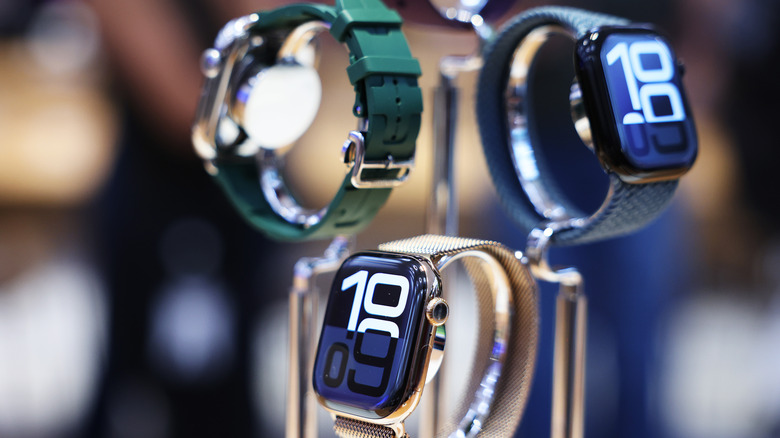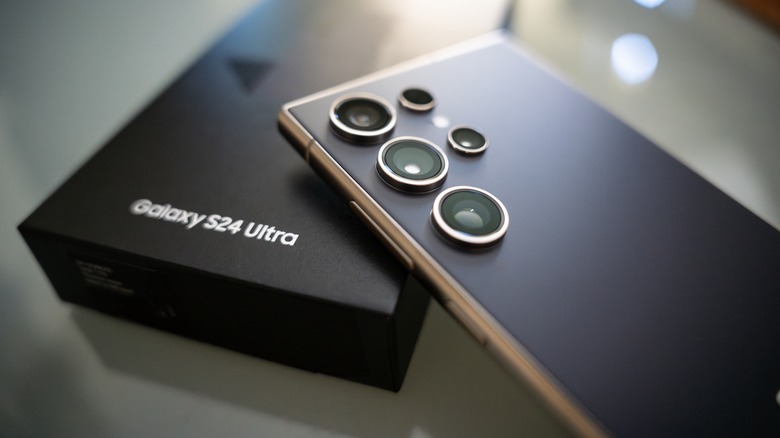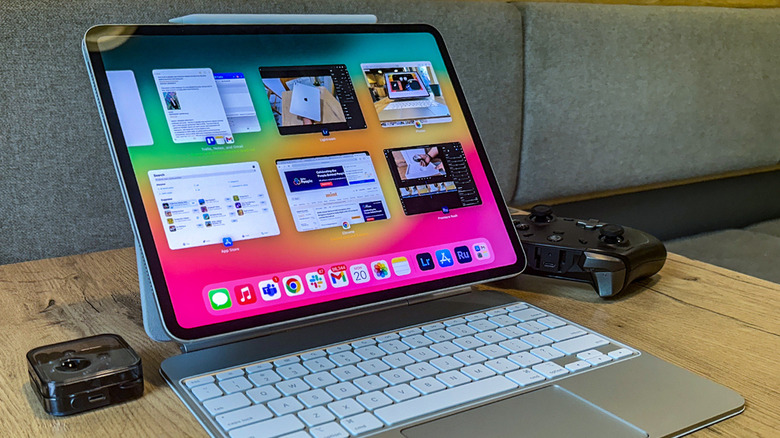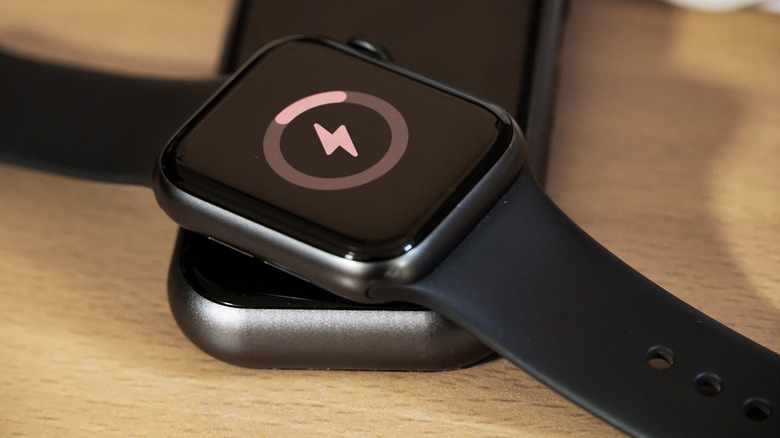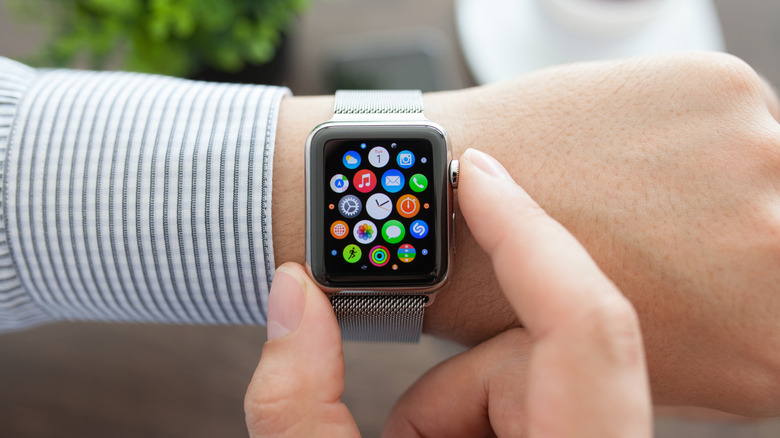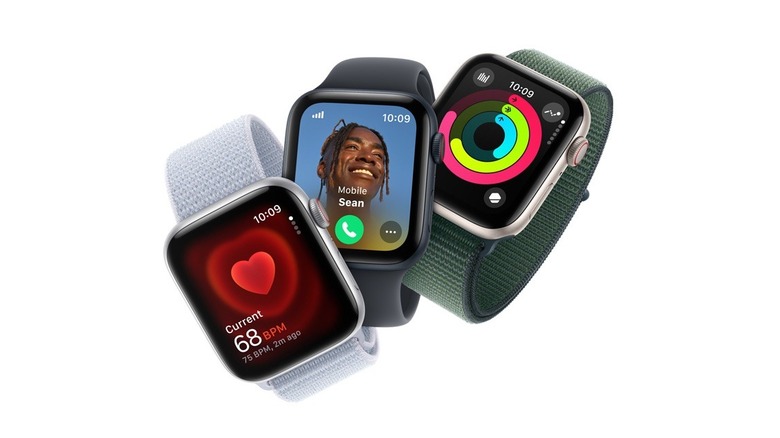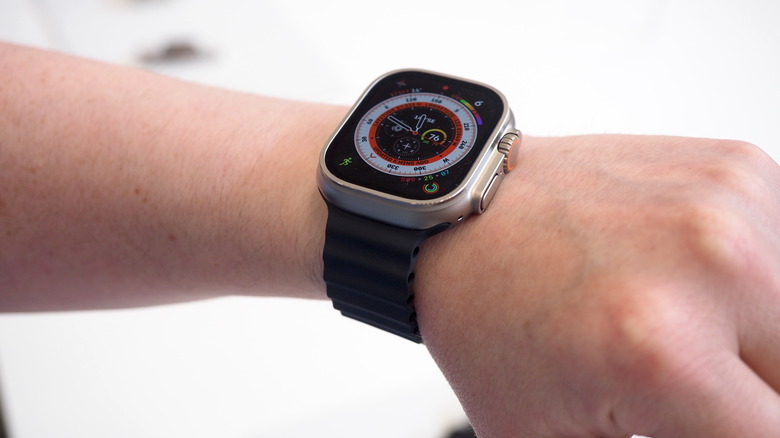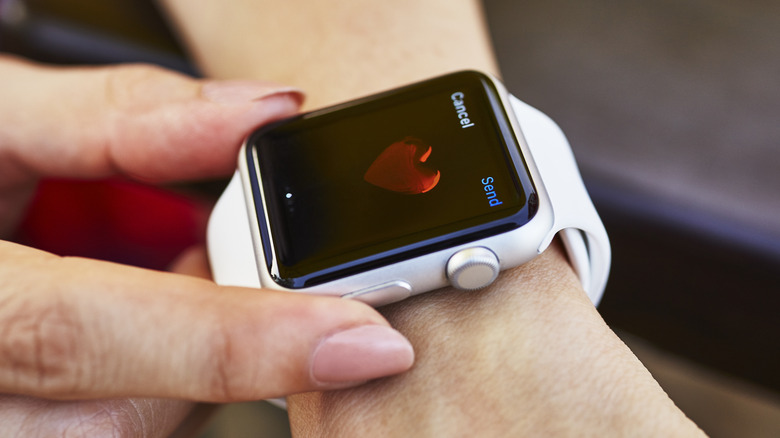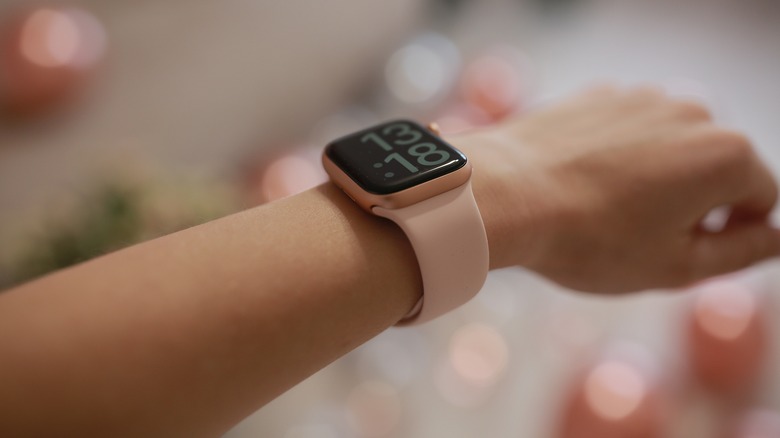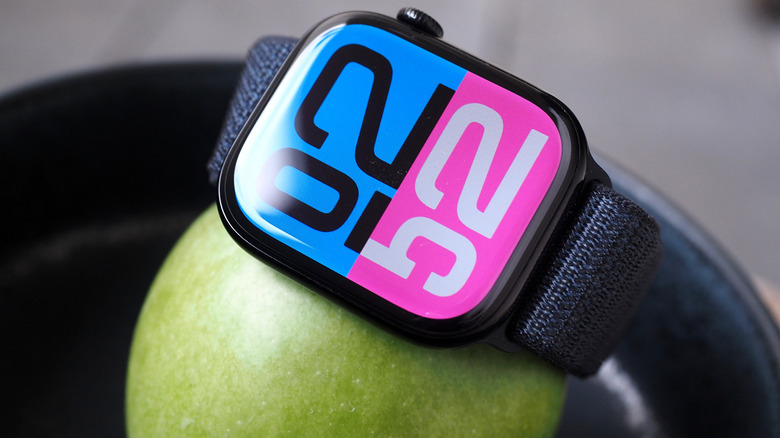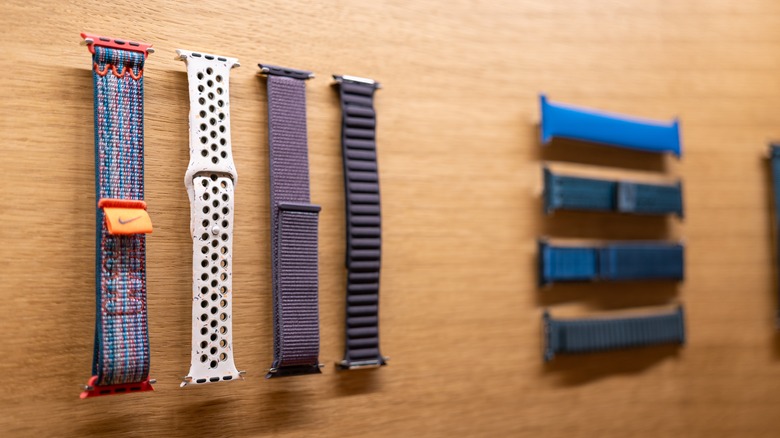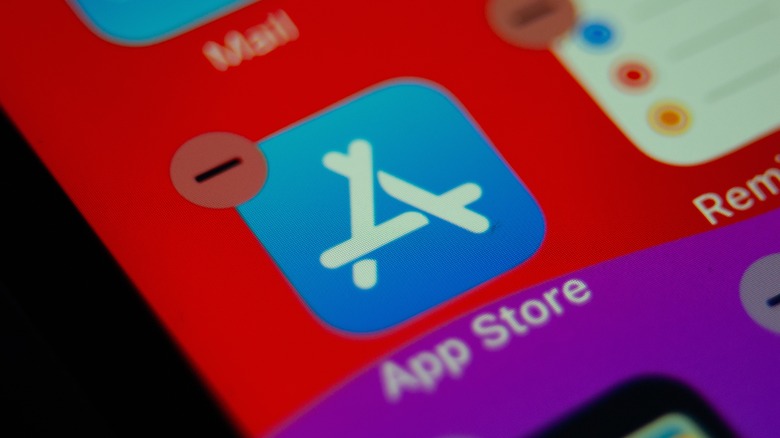12 Things You Should Know Before Buying An Apple Watch (New Or Used)
The Apple Watch was released in 2015 and has since been one of the brand's most popular products — and one of the best smartwatches, period. Many users praise Apple Watch for having a superior operating system (watchOS) to Android, better interaction thanks to the Digital Crown and Taptic Engine, great battery life, a vibrant screen, and more thoughtful features. You get Apple's strong privacy protections when it comes to sensitive, personal health metrics, like workouts and sleep quality. It's one of a few products in the Apple lineup that just about everyone agrees is pretty great, even if it's mostly just bringing notifications to your wrist. Before you walk into an Apple Store right now and buy one, though, be aware of a few caveats.
No, we're not talking about the fact that the latest Apple Watch 10 just feels like a slight spec bump over the previous Apple Watch 9. Nor is this an article for Android users who have switched to Apple and are looking for a crash course on what it is and what it does. Think of this as a few things worth keeping in mind before you buy an Apple Watch — regardless of what phone you already have, your reason for buying one, and whether the watch is new or used.
The Apple Watch (mostly) doesn't work with Android
"An Apple device refuses to play nice with non-Apple devices?" you might be thinking with a sarcastic grin on your face, "say it ain't so!" Unfortunately, in this case, it's more than just iPhones demoting any text from an Android to SMS out of green-bubbled spite. It's that Apple Watches — barring some workarounds — virtually refuse to work with Android at all. They require an iPhone to be set up and to function. Apple has alleged that they've tried to make their watches work with competitors without success — even with recent developments like RCS finally being on iPhone. Unless the government steps in and specifically forces Apple to make watchOS compatible with Android, the product will remain deep inside the confines of the walled garden.
Where there is a will, there is a way, and you can technically connect an Apple Watch to an Android device provided the former has an LTE plan. You basically have to trick the Apple Watch into thinking that your Android is an iPhone; you set up the Apple Watch with the iPhone first, then turn both phones off and swap the SIM card. Upon booting up the Android phone, the Apple Watch will connect to it. Keep in mind, you will lose a ton of functionality; running iPhone-based apps, sending normal SMS, or updating watchOS — among other things — simply will not work. After that pricey Apple Tax, this sneaky hack probably isn't worth it.
Apple Watch doesn't work with iPad
The Apple Watch is quite chummy with the iPhone and Mac. You can unlock both with your Apple Watch, as one example of the benefits you get for owning both. You'd be forgiven for thinking the same would apply to an iPad, so prepare for some disappointment: In the eyes of your iPad, the Apple Watch does not exist. You can't set it up, pair it, manage it, or use any of the cool features between an Apple Watch and an iPhone and Mac on the same iCloud account.
It's quite strange since the iPad integrates well with iPhone and Mac, supporting Handoff and working as an extended screen for your Mac. Yet, Apple Watch Handoff works with iPhone and Mac, but not iPad.
Why is this the case? It's anyone's guess at this point. Ours is that Apple is trying to make its iPad Pro more enticing. The non-Pro iPads have a fingerprint sensor instead of Face ID, but from personal experience, it is neither reliable nor convenient. Being able to instantly unlock your iPad with your Apple Watch would make you much less likely to spend $1,000 on the iPad Pro M4. The iPad is a hard sell as it is considering it can't even replace your laptop, so Apple is naturally going to do whatever it can to get you to buy it.
Battery life requires different charge times every day
The Apple Watch needs excellent battery life to track vitals day and night. And, to be fair, it does; both the Series 10 and the SE run for 18 hours, while the Ultra gets about 36. But there are 24 hours in the day, not 18. So unless you have the Ultra, you're going to have to charge the Apple Watch more frequently to ensure it doesn't die while you're sleeping; after all, health and fitness tracking is a large chunk of why most people get one.
Because it's 18 hours of battery life (or 36 hours), the time of day that you charge your Apple Watch will change every day. Sometimes you'll be charging it in the morning, sometimes at night, sometimes at lunch. iPhones don't have that problem since most people charge them overnight and again when they get home. The Apple Watch is trickier since it requires its own proprietary wireless charger and takes about 1.5 hours (2 hours, speaking from experience) to charge to full — so there's a strong chance your watch will die when you're out, and it'll be a hassle to juice it up.
By disabling a few settings, you can extend battery life to over 24 hours and stop your Apple Watch from dying so fast. Enabling Reduce Motion (which drops the frame rate) in Accessibility settings goes a long way. Even so, you'll have to be mindful of charging if you want the Apple Watch to get a truly comprehensive look at your health.
You may need a separate cell service plan to use it without your iPhone
Part of the reason the Apple Watch is so great is that it leans heavily on the processing power of the iPhone via Bluetooth, giving the illusion that it can do more. As a consequence, this means your Apple Watch is fairly helpless when out of Bluetooth range. Speaking again from personal experience, it struggles to do much even if you do have a solid Wi-Fi connection, and it's limited strictly to native apps. An Apple Watch Cellular can subsist on its own and let you use it without an iPhone, provided you're okay with paying for a separate carrier plan. So if you need your Apple Watch to be a strong, independent smartwatch that doesn't need an iPhone, it'll cost you.
YouTuber Matt D'Avella tried living with only an Apple Watch Cellular for 30 days as part of a phone-free minimalism experiment. Though he was severely limited with that tiny screen and only a fraction of his usual third-party apps, he was able to do quite a lot — enough to get by, at least. If you need a watch that isn't going to crap out because you don't have your iPhone nearby (whatever your reasons may be), then you are going to have to budget for that additional monthly plan.
The SE model is probably good enough for most people
Apple has never been known as a budget brand, but when it makes "budget" products, they often perform surprisingly well. The iPhone SE (for the odd years Apple decides to make one) is always a beloved model. The same goes for the Apple Watch SE. Though the marketing for the Series 10 and Ultra might suggest otherwise, the SE is the best option for most people. The reason? You're getting most of the functionality for sometimes a quarter of the price.
To give an example, let's compare the Apple Watch SE to the Apple Watch Series 10. For an extra $150, the only major features that justify an upsell are slightly bigger size options, an always-on display, ECG readings, temperature readings, and on-device Siri. The rest are only minor upgrades, like faster charging and higher brightness levels. That's basically it.
All the other things you'd expect from an Apple Watch — 50m waterproofing, emergency SOS features, vitals tracking, sleep tracking, heart arrhythmia warnings, etc. — are all there, and watchOS for SE is almost as feature-rich. The Series and Ultra used to have blood oxygen measuring as a justification for the price bump, but this was removed (we'll get into that later). The only real downside to buying the SE — aside from fewer features — is that it's a few years out of date; the last SE was released in 2022. Maybe wait for a refresh before buying.
Rough and tumble users should get an Ultra
The Apple Watch Ultra is a lot like the iPad Pro, a ludicrously overpriced luxury $800 watch that has to work a miracle to justify its existence. Again, the SE probably does most of what the Ultra can. That said, there is one conceivable situation where the Ultra could be a necessity: for users who will subject it to a gauntlet of abuse. As in, someone whose activities will scratch, bang, slam, drop, and submerge their watch on the regular like the commercials envisioned.
To see what we are talking about, check out this durability test by Apple Track. Sam rubs it through the dirt, scrapes it with rocks, and in one instance, even dangles it out of a moving car while it drags over the asphalt and unpaved rock. At the end of these tests, the Ultra came out with only minor cosmetic damage. Sam stepped things up by literally slamming the Ultra watch face-first (hard) against various surfaces — concrete walls, bollards, brick walls, metal chairs, asphalt blacktop, you get the idea.
It turned out that, for once, Apple advertising was not an exaggeration. The Ultra survived what should have been devastating, screen-shattering hits dozens of times. It was only by hit 42 that a couple of pixels died, and the screen stopped working at hit 51, but the glass never cracked. So yeah, this watch is so tough it could serve even a Marvel superhero well.
It might be able to warn you early about health conditions
If your family has a genetic history of heart disease, the key is catching it as early as possible so you can treat it effectively. Aside from regular doctor's appointments and paying careful attention to your symptoms, there's not much else you can do. An Apple Watch could help warn you of certain conditions long before they rear their ugly heads.
Take this story from Business Insider as just one of many examples. Adam Croft learned that he had atrial fibrillation (basically an irregular heartbeat) thanks to a notification from his Apple Watch. He was able to seek medical attention before things got more serious — potentially even deadly. His story is far from the only one. Many others credit their Apple Watch for warning them of life-threatening conditions.
Now to be clear, an Apple Watch is not a certified medical device. There's no guarantee that it's correct, and it can only warn of heart problems related to heart rate. However, it can also call emergency services if you fall, or if you get into a car crash. So for these reasons, this is the best smartwatch to get for health concerns and general safety.
Buy an older Apple Watch (or one outside the US) if you want blood oxygen measurements
As mentioned, blood oxygen measurements were one of the big selling points of the Apple Series and Ultra, but not anymore. Apple will remove the Apple Watch blood oxygen feature over a U.S. sales ban. The company Masimo took Apple to court alleging that the tech giant had infringed upon its pulse oximetry technology. So while awaiting a verdict, Apple has been banned from shipping the feature. It disabled pulse oximetry on the software side on all new Series 9 and Ultra 2 units, and all future Apple Watches (via TIME). It's believed that the feature may not return until 2028. While it's great that Masimo is getting its due, it really sucks for customers with affected models — or for our purposes, you, if that feature appeals to you.
If pulse oximetry is something you need or want, there is a way to still get it: Buy a watch outside the United States. The ban only affected imported watches to the U.S. and nowhere else. You might be able to buy a Series 8 or Ultra 1 from a third party that was imported new to the U.S. before the disabling took place. Or better yet, take a little vacation to Mexico and drop by the Apple Store.
They're great for keeping track of children
Another great use case for the Apple Watch is to keep tabs on your little ones. You'll need an Apple Watch Cellular with its own data plan (remember, the Apple Watch doesn't work alone otherwise), but doing so would give you peace of mind when sending your kid off to play with their friends. The first most obvious benefit is you could use Find My to see where they are in real time. The aforementioned fall detection could be incredibly handy, too, if they take a hard fall while riding their bike. You could text and call them easily when away from home, and use the Walkie-Talkie feature to tell them it's time for dinner if they're nearby.
Aside from that, it could also keep track of their physical activity. The Apple Watch continually tracks your activity regardless of whether or not you've started a workout — how much you walk, how long you spend sitting down, and how much you get your heart rate up. Plus, it gamifies and incentivizes all this with the activity rings. For parents worried about kids who spend too much time playing games, this could be a useful accountability tool. Just be sure your kid is not the sort who's prone to losing things.
Siri only works on-device for Series 9 (and above)
One of the biggest benefits of the Apple Watch is being able to summon Siri from your wrist. It's super helpful if your hands are busy or dirty, such as setting a timer while cooking. But remember, we've established at this point that your Apple Watch relies on your iPhone for a lot of things, and one of those is Siri requests. Anytime you're away from your iPhone, Siri will have to work over the internet. More likely, though (speaking again from personal experience), Siri won't respond at all (even with good Wi-Fi), or will be painfully slow. This is especially annoying when you don't have Wi-Fi or cell signal and you need to do something that doesn't require internet, like setting a reminder.
In that case, you should probably get the Series 9 or later. The new S9 chip (or later) can run Siri on-device. It's the same situation for the original Apple Watch Ultra; you will need the Ultra 2 for those on-device requests.
You can buy more watchbands elsewhere
The Apple Watch is incredibly versatile because you can swap out the watchband in seconds to fit any outfit or any mood. Regardless of whether you're going to a swanky dinner or playing basketball, there is a watchband to match. Unfortunately, one look at the prices on the Apple Store page and you will lose your enthusiasm to build a collection of them. Think $49 for a basic fabric band on the SE and Series, and $99 (sometimes $199) for the Ultra. Yikes. Even if these are the highest-quality bands around (and let's be real, they probably are not), you can get much cheaper ones that still serve you well.
Check just about any online retailer, like Amazon. This Nereides band runs you $18.99, with 4.4 out of 5 stars across 10,000 reviews. It's half the price of Apple's cheapest offering, yet reviewers praise it for how high-quality, comfortable, and rugged it is. This is only one among many options for watchbands and manufacturers. You could go hog-wild and find dozens of bands while still keeping under Apple's steep $49 asking price.
App support is limited
We've more than belabored the point that your Apple Watch needs an iPhone to achieve its full potential. To hit the dead horse one final time, know this: Many app developers don't even bother creating an app for the Apple Watch, specifically. WhatsApp and Telegram are two of many examples. Instead, your Apple Watch will display notifications for unsupported apps installed on your iPhone, and allow for basic interaction with them, such as responding to a message. Once you leave Bluetooth range, though, this functionality naturally disappears. We mention this as a caveat for anyone who purchases the Apple Watch Cellular with the intention of using it extensively away from an iPhone, but still needs those unsupported third-party apps.
In some cases, you may have a third-party alternative that can get the job done. There's no Safari on the Apple Watch (for obvious reasons), but if you really need a browser, try µBrowser. If you want to watch YouTube videos (again, no official version is available) then try WatchTube. Using any app on such a small screen for longer than a few seconds is going to be a frustrating experience, make no mistake, so keep your expectations in check if you plan to use the Apple Watch for long periods away from an iPhone.
